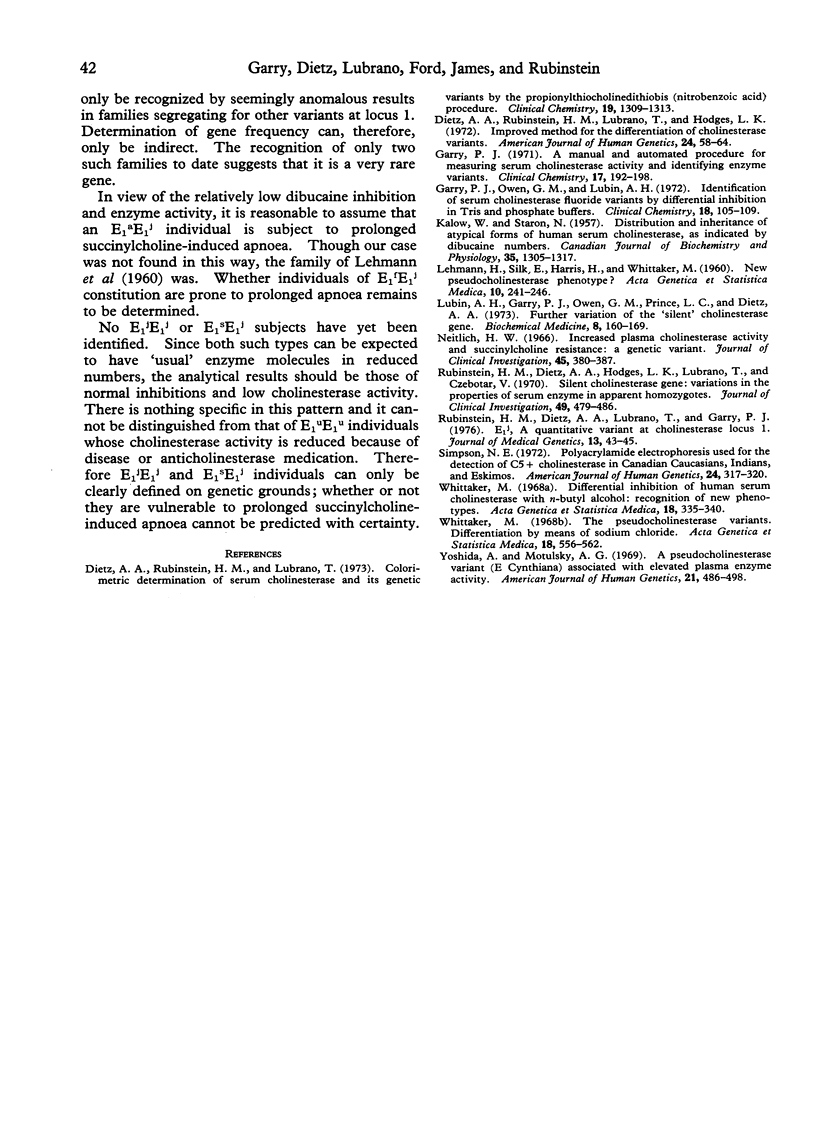Abstract
A family (H-J pedigree) segregating for the A and F alleles at cholinesterase locus 1 is described. Apparent anomalous results led to the recognition of a new allele (E1j) also segregating in the family. The data are consistent with the hypothesis that the the E1j causes reduction of 'usual' (E1u) molecules by about 66%. Whether this is because of retarded synthesis or accelerated degradation of serum cholinesterase remains to be determined.
Full text
PDF




Selected References
These references are in PubMed. This may not be the complete list of references from this article.
- Dietz A. A., Rubinstein H. M., Lubrano T. Colorimetric determination of serum cholinesterase and its genetic variants by the propionylthiocholine-dithiobis(nitrobenzoic acid)procedure. Clin Chem. 1973 Nov;19(11):1309–1313. [PubMed] [Google Scholar]
- Dietz A. A., Rubinstein H. M., Lubrano T., Hodges L. K. Improved method for the differentiation of cholinesterase variants. Am J Hum Genet. 1972 Jan;24(1):58–64. [PMC free article] [PubMed] [Google Scholar]
- Garry P. J. A manual and automated procedure for measuring serum cholinesterase activity and identifying enzyme variants. Differentiation by means of Tris and phosphate buffers. Clin Chem. 1971 Mar;17(3):192–198. [PubMed] [Google Scholar]
- Garry P. J., Owen G. M., Lubin A. H. Identification of serum cholinesterase fluoride variants by differential inhibition in tris and phosphate buffers. Clin Chem. 1972 Feb;18(2):105–109. [PubMed] [Google Scholar]
- KALOW W., STARON N. On distribution and inheritance of atypical forms of human serum cholinesterase, as indicated by dibucaine numbers. Can J Biochem Physiol. 1957 Dec;35(12):1305–1320. [PubMed] [Google Scholar]
- LEHMANN H., SILK E., HARRIS H., WHITTAKER M. A new pseudocholinesterase phenotype? Acta Genet Stat Med. 1960;10:241–246. doi: 10.1159/000151128. [DOI] [PubMed] [Google Scholar]
- Lubin A. H., Garry P. J., Owen G. M., Prince L. C., Dietz A. A. Further variation of the "silent" cholinesterase gene. Biochem Med. 1973 Aug;8(1):160–165. doi: 10.1016/0006-2944(73)90019-7. [DOI] [PubMed] [Google Scholar]
- Neitlich H. W. Increased plasma cholinesterase activity and succinylcholine resistance: a genetic variant. J Clin Invest. 1966 Mar;45(3):380–387. doi: 10.1172/JCI105353. [DOI] [PMC free article] [PubMed] [Google Scholar]
- Rubinstein H. M., Dietz A. A., Hodges L. K., Lubrano T., Czebotar V. Silent cholinesterase gene: variations in the properties of serum enzyme in apparent homozygotes. J Clin Invest. 1970 Mar;49(3):479–486. doi: 10.1172/JCI106257. [DOI] [PMC free article] [PubMed] [Google Scholar]
- Rubinstein H. M., Dietz A. A., Lubrano T., Garry P. J. E1j, a quantitative variant at cholinesterase locus 1: immunological evidence. J Med Genet. 1976 Feb;13(1):43–45. doi: 10.1136/jmg.13.1.43. [DOI] [PMC free article] [PubMed] [Google Scholar]
- Simpson N. E. Polyacrylamide electrophoresis used for the detection of C5+ cholinesterase in Canadian caucasians, Indians, and Eskimos. Am J Hum Genet. 1972 May;24(3):317–320. [PMC free article] [PubMed] [Google Scholar]
- Whittaker M. The pseudocholinesterase variants. Differentiation by means of sodium chloride. Acta Genet Stat Med. 1968;18(6):556–562. doi: 10.1159/000152180. [DOI] [PubMed] [Google Scholar]
- Yoshida A., Motulsky A. G. A pseudocholinesterase variant (E Cynthiana) associated with elevated plasma enzyme activity. Am J Hum Genet. 1969 Sep;21(5):486–498. [PMC free article] [PubMed] [Google Scholar]


